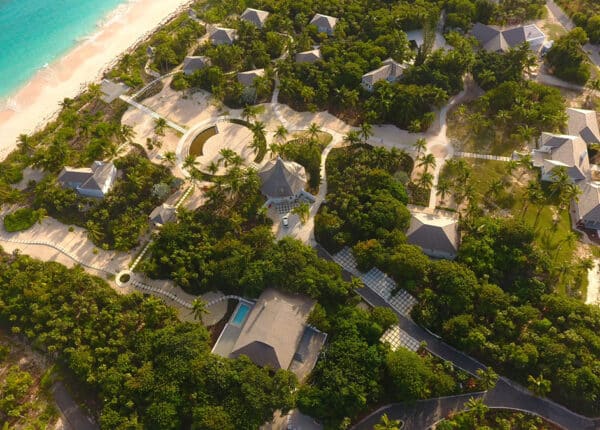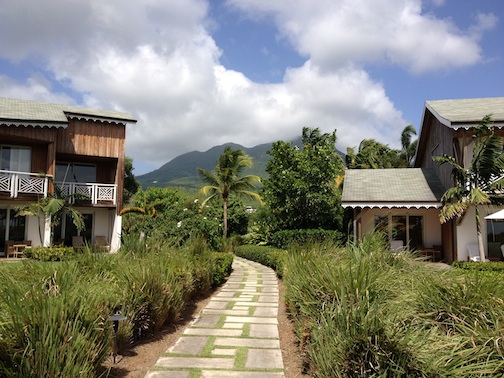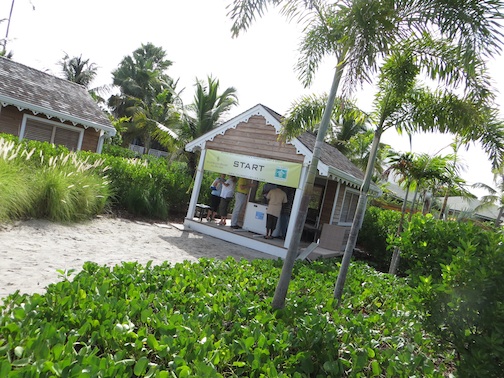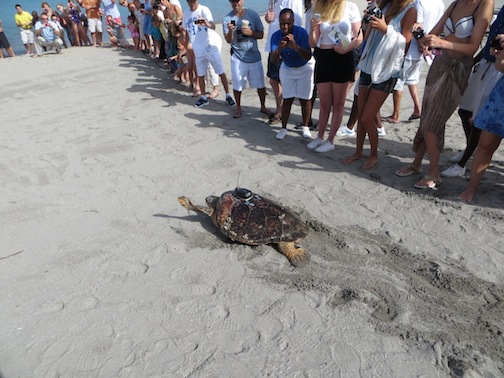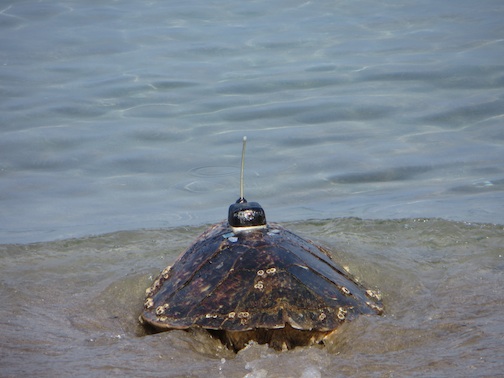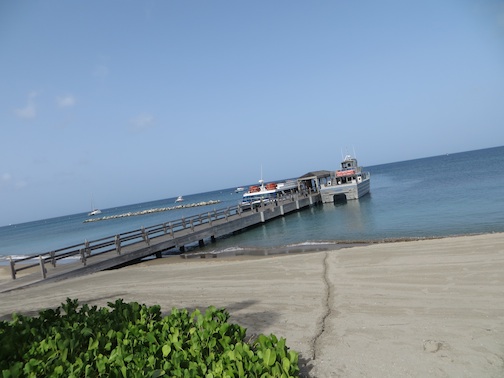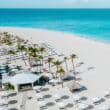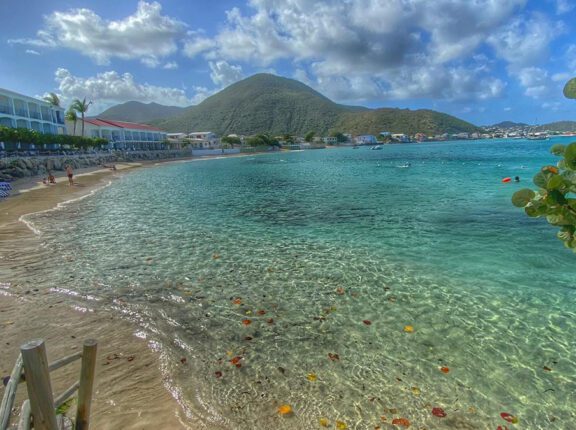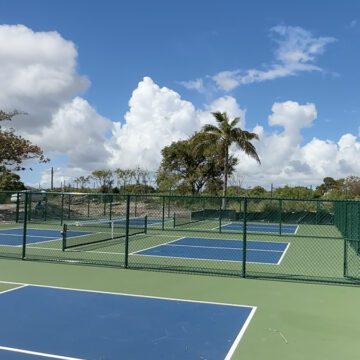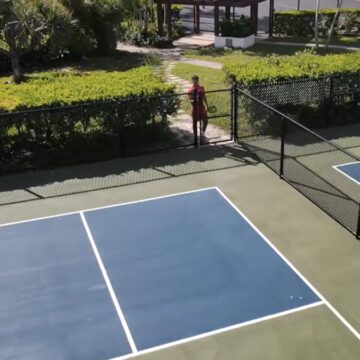Sea Turtles — a Special Kind of Tourist at the Four Seasons Nevis
Above: the Four Seasons Resort in Nevis (All photos by CJ)
By Alexander Britell
NEVIS — IT’S LATE EVENING, and Pinney has arrived in Nevis by sea. After a warm greeting to the island, she is shepherded by VIP transport to the Four Seasons Resort and immediately escorted to one of its new beach houses.
It’s a welcome fit for any visitor to the Four Seasons — but Pinney is a rather unique traveler.
A hawksbill turtle, Pinney has, like many of her relatives, come to Nevis to nest.
Since 2006, the Four Seasons Resort has been working with the Sea Turtle Conservancy and the local Nevis Turtle Group to watch, study and tag turtles nesting on Nevis and in the Eastern Caribbean.
The aim is to outfit them with special global positioning technology that facilitates the study of the mercurial movements of one of the world’s oldest living species.
Like many before her, Pinney received her GPS tag and, after a night in the aforementioned beach house, was sent off by scores of resort guests on Pinney’s Beach (her namesake) as she was re-released into the wild.
But the story of Pinney’s visit — and her reception at the Four Seasons — is far more complicated.
WHILE SEA TURTLES have been around for 100 million years, their nesting habits — and navigational paths — remain mysterious.
And given their small number, still declining for a series of reasons, it is particularly difficult to study them.
Lemuel Pemberton, Nevis’ director of fisheries, founded the Nevis Turtle Group in 2001. Pemberton’s crusade to protect the creatures has grown into a force for conservation on the island.
But as Pemberton’s group developed, it needed help and resources, and he eventually partnered with the Four Seasons Resort, the island’s largest employer, along with the global Sea Turtle Conservancy, to expand the programme.
Now, the Nevis Turtle Group’s turtle watching expands with Four Seasons guests, who join Pemberton and his colleagues to scour beaches for nesting turtles.
Several times each week — or upon news of a turtle coming to shore (sometimes even at the resort itself) — Pemberton and a band of devoted volunteers, many of them kids, head to the beaches of Nevis to watch for the creatures, some of whom receive passage to the Four Seasons.
THERE ARE GENERALLY two types of turtles that nest in Nevis: the leatherback and the hawksbill.
Internationally, both are considered “critically endangered,” according to David Godfrey, the executive director of the Sea Turtle Conservancy, which is based in Gainesville, Fla.
“It’s for different reasons,” he says of their status. “But because they’re in such bad shape, what is done by Nevisians and people in St Kitts to safeguard their habitat and to limit human impact on these species is very important to their survival.”
It’s not always leatherbacks and hawksbills, however. Neve, another recent visitor to Nevis, was the first-ever green sea turtle tagged on the island last month.
“We have a very dedicated group of volunteers on both islands, and they volunteer their time, monitor the beaches and are assessing what’s happening with the population, basically doing biological field research,” he says.
What the last few years have found is that the overall trend is slightly down in the twin-island federation.
“We’re losing the numbers of hawksbills and probably leatherbacks as well,” he says.
As for leatherbacks, while some eggs are still taken from beaches, their decline is due in larger part to the species’ susceptibility to commercial fisheries.
FOR HAWKSBILLS like Pinney, it’s another story.
“What’s happening here, is that they’re very vulnerable, both in the water and on land,” he says. “When they come to nest, they’re sort of sitting ducks, and people in these islands for generations have eaten hawksbill and have harvested this turtle for their shells, despite laws outlawing their taking from the beach while they’re nesting.”
The harvesting has traditionally been for two reasons — for shells, the trade in which is illegal under international conventions — and for meat and eggs. (Of course, with the poisonous coral that hawksbills sometimes eat — which can be deadly to humans if ingested — turtle poachers are often risking a meal of turtle being their last).
But the poachers persist. Godfrey pointed to an episode on a watch last year, when he and Pemberton, searching for nesters, came upon a group of men, seeking a turtle for a purpose that did not involve research.
“We came upon four guys sitting back in the bushes, camped out and waiting for a turtle that was coming out of the sea,” he said. “And they were already there, and we went in front of them, and just stood there and let the turtle nest, and we took it — but if we hadn’t been there…”
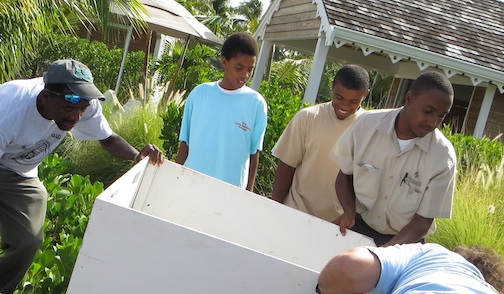
Lemuel Pemberton (left), joined by young members of the Nevis Turtle Group, helps release a turtle after tagging
NEVIS’ STORY is no different to the situation on any number of islands in the Caribbean. And with a range of travel that spreads as far as Nicaragua to the west, the Caribbean’s unofficial maritime ambassadors need help.
But the work on Nevis has been critical – both to spreading awareness and supporting research.
“The most important thing they’ve done [in Nevis] is begin to gather information about the status of these animals, where there was none before,” Godfrey says. “It takes this rigorous implemented protocol on the beach at night, night after night, for a period of years, to accumulate solid information on these animals — and they’re doing that.”
Perhaps more important, he said, has been the increase in awareness. Along with an ever-growing number of hotel guests who make the nighttime trek, local Nevisians, many of them not even teenagers, join Pemberton on his turtle walks.
“You’ve got Lemmy and his ‘minions,’ as I call them, mostly young people, who are volunteering their time and doing something constructive at night, assisting with the work,” Godfrey says. “They become emotionally attached to their turtles, and they and their families obviously know what’s going on — and that’s really how it starts.”
More awareness is the key, both Pemberton and Godfrey say.
“You have to begin creating a level of awareness, and then concern, and then action,” he says. “We’re at the point in Nevis where we know enough about the turtles, and we’re beginning to develop a strong sense of pride in turtles in this country. With our programme here with the Four Seasons, with the annual summer camp that involves the local kids, we’re building this level of awareness.”
Next, he says, will be going to the government and looking for a ban on hawksbill harvesting in the country.
“That would go a long way toward beginning to provide some level of protection to these animals,” he says.
The ultimate goal is to help the turtles live independently, Godfrey says. That will be the key to helping them repopulate.
“They’ve survived for 100 million years,” Godfrey says. “They know how to reproduce, they know how to navigate the open seas, find food — they’re very adaptable, and they will recover quite on their own.”
LOVER’S BEACH is located near Nevis’ small airport on the northern tip of the island.
It’s a steep drop to the sand, and finding a turtle is not easy. The guides, armed with red lights (sea turtles do not respond favourably to white light), lead the group, which must traverse sand, unseen rocks and constantly-changing gradients in the search for the next Pinney.
Visibility is very low. One can see the moon, perhaps the flicker of a flashlight and the dark silhouette of the foothills of St Kitts across the water.
When a turtle does arrive, the group halts. If there others are searching a separate portion of beach, a few flashes of light tell them a turtle has been found.
While the ultimate outcome is to find a turtle, watch it nest, record its critical information and tag it, it also provides a unique experience for the Caribbean traveler.
And Pemberton and Godfrey say there could be an added benefit to Nevis and the Caribbean at large in stepping up the fight to protect turtles: eco-tourism.
What if the number of resort guests who regularly join the Turtle Walk found kindred spirits at other resorts, on other islands?
“The hawksbill might nest three times, and one turtle can be on the beach half a dozen times at least during a season,” Pemberton says. “That’s half a dozen opportunities for them to be used for eco-tourism opportunities — and that would be better than the single use that used to happen before.”
